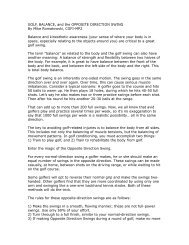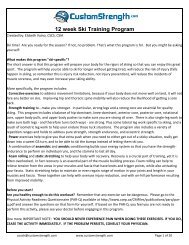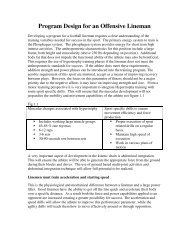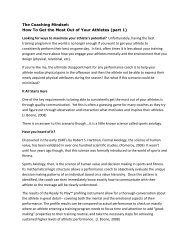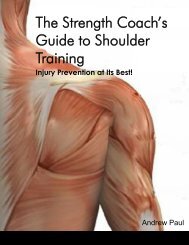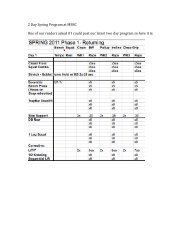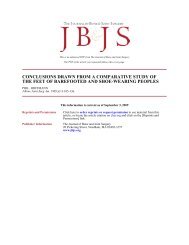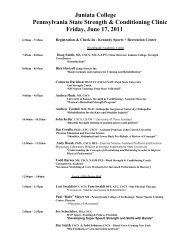Sprint Interval Training - “It's a HIIT - Strength Coach.com
Sprint Interval Training - “It's a HIIT - Strength Coach.com
Sprint Interval Training - “It's a HIIT - Strength Coach.com
You also want an ePaper? Increase the reach of your titles
YUMPU automatically turns print PDFs into web optimized ePapers that Google loves.
espond well to SIT. They began the same SIT protocol with The X‐iser® Machine described in the above pilot study<br />
on August 10, 2007. The first four sessions were on full resistance to decrease the intensity in the early stages, it<br />
was then lowered to increase the intensity once the patient was <strong>com</strong>fortable. With session 11, he began using 8<br />
lb. dumbbells to add the bilateral curl and press motion while stepping. By session six, his symptoms were<br />
noticeably less frequent; they now only occurred if the patient bound upstairs after eating a meal. By session 10,<br />
they were gone entirely. The patient took a 6‐week vacation out of the country after session 10. The symptoms<br />
were nonexistent during that time and he reportedly “sprinted up steps all over the cruise ship and all over<br />
Europe.” Upon his return, he continued only because he liked the training and went on to purchase his own X‐<br />
iser® for home use. Three months later, the patient was still without symptoms. The patient had a followup<br />
treadmill test on October 19, 2007. He exercised 13 minutes and 20 seconds on the Bruce protocol stopping only<br />
because of fatigue. The cardiologist wrote, “He is off the scale in terms of exercise tolerance for his age and<br />
gender. He had no chest pain. He had a normal hemodynamic response to exercise with a peak systolic pressure<br />
of 172. There are no ECG changes diagnostic for myocardial ischemia and no arrhythmias. Normal resting left and<br />
right ventricular systolic function with no echo evidence for inducible ischemia.“ Interestingly, his initial treadmill<br />
test and his final treadmill test were both 13 minutes in duration; however, the first one, in 2005, was stopped<br />
because his heart rate got too high. In 2007, after SIT on The X‐iser® Machine, his test was stopped because of<br />
fatigue rather than his heart rate being too high. Schultz et al., recently examined the effect of excessive long‐term<br />
exercise on cardiac function and myocyte remodeling in hypertensive heart failure rats to see if it attenuated the<br />
pathological remodeling under hypertensive conditions 111 . Compared with sedentary hypertensive rats, excessive<br />
exercise resulted in a 21% increase in left ventricular diastolic dimension (p < 0.001), a 24% increase in heart to<br />
body weight ratio (p < 0.05), a 27% increase in left ventricular myocyte volume (p < 0.01), a 13% reduction in<br />
ejection fraction (p < 0.001), and a 22% reduction in fractional shortening (p < 0.01). Excessive exercise also<br />
resulted in greater fibrosis and did not prevent activation of the fetal gene program in hypertensive rats. It was<br />
concluded that excessive exercise, in the untreated hypertensive state can have deleterious effects on cardiac<br />
remodeling and may actually accelerate the progression to heart failure. It is worth noting that Mr. Swinscoe’s<br />
patient had a blood pressure of 142/86 mmHg at his initial stress test in 2005 and had been re<strong>com</strong>mended to take<br />
35



